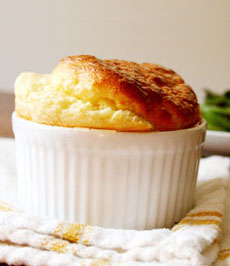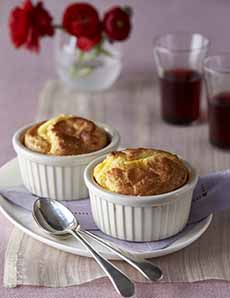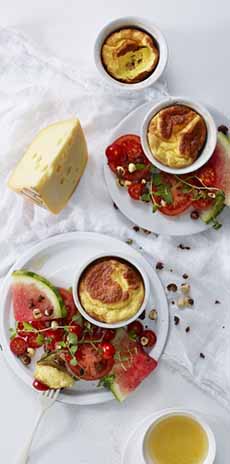Classic Cheese Soufflé Recipe & The History Of The Soufflé
|
|
May 18th is National Cheese Soufflé Day. We spent most of our 20s making soufflés, both sweet (chocolate, vanilla, fruit) and savory (cheese, fish, spinach). The frenzy with which we turned them out was, in retrospect, our own mash-up of Julie & Julia and Groundhog Day. Modern soufflés were developed in France in the 18th century. The cheese soufflé, initially one course of a larger meal, evolved in modern times to a light main course, served with a green salad and a glass of rosé or white wine. > The history of the soufflé is below. > More delicious soufflé recipes are also below. To make a cheese soufflé, grated cheese is mixed into a béchamel (a type of white sauce). In the course of making cheese soufflés over and over again, we tried different cheeses, from Comté and Gruyère to Cheddar and Stilton. The cheese you prefer will depend on how mild or sharp you like your cheeses, but start with Comté or Gruyère, two French basics. There are a few “givens”: Ingredients For 4 to 6 Side Servings Or 2 Mains 1. PLACE the rack in the center of the oven and preheat to 400°F. Generously butter one 10-cup soufflé dish or six 1-1/4-cup ramekins. Sprinkle the dish(es) with Parmesan cheese to coat and tap out the extra. If using ramekins, place all six on a rimmed baking sheet for easy removal from the oven. 2. MELT the half stick of butter in a large, heavy saucepan over medium heat. Add the flour, cayenne pepper, and nutmeg. Cook without browning until the mixture begins to bubble, whisking constantly, about 1 minute. 3. GRADUALLY WHISK in the milk, then the wine. Whisk constantly until the mixture is smooth, thick, and beginning to boil, about 2 minutes. Remove from the heat. 4. BLEND the egg yolks, salt, and pepper in a small bowl. Add the yolk mixture all at once to the white sauce and whisk quickly to blend. Fold in the Gruyère and the Parmesan cheeses (the cheeses do not need to melt—they’ll melt in the oven). 5. BEAT the egg whites in a large bowl with an electric mixer, until stiff but not dry. Fold 1/4 of the whites into the [lukewarm] cheese base to lighten. Fold in the remaining egg whites. 7. PLACE the soufflé in the oven and immediately reduce the heat to 375°F. Bake the soufflé until it is puffed, golden, and gently set in the center—about 40 minutes for the large soufflé or 25 minutes for the ramekins. 8. REMOVE the baked soufflé with oven mitts to a heatproof platter (or individual plates for the ramekins), and serve immediately. |
|
|
THE HISTORY OF THE SOUFFLÉ The word soufflé is the past participle of the French verb souffler, “to puff up”—which is exactly what happens when the combination of a flavored egg custard base and beaten egg whites is baked into an airy, spongy, quasi-moist, quasi-cakey concoction, just firm enough to hold its shape. While a soufflé can be baked in a variety of containers, fluted soufflé dishes or individual ramekins have become traditional over the years. Soufflés can be savory and served as a main dish or sweetened as a dessert. There are dessert “frozen soufflés,” but the chemistry is different—dense, frozen cream provides the shape, not fluffy, beaten egg whites. A hot soufflé puffs up to an impressive height because of the bubbles of hot air trapped in the batter. As the soufflé cools, the hot air contracts and the soufflé deflates or “falls.” That’s why a soufflé needs to be served immediately to impress with its full majesty; although fallen soufflés are less airy, they taste just fine. According to the Oxford Companion to Food, custards, puddings, and pies have been made since Medieval times, and Renaissance European cooks used whisked egg whites—a critical component of the soufflé—in a variety of dishes. But it was not until the 17th century that chefs perfected meringue, a technique that then enabled them to develop the soufflé. While the majority of today’s soufflés have a custard base (egg yolks combined with the flavor element), the hot soufflé had as its starting point a roux (a cooked mixture of flour and butter), and modern recipes can still be found with a flour base. This type of soufflé was invented in France in the late 18th century. The great chef and restaurateur Antoine Beauvilliers, who opened the first “real” restaurant* in Paris in 1782, was possibly serving soufflés at that date; his L’Art du Cuisinier, published in 1814, includes recipes. The dish was an immediate success and Beauvilliers, according to Brillat-Savarin, “was for more than fifteen years the most famous restaurateur in Paris.†” According to FoodReference.com, the word soufflé first appeared in English in Louis-Eustache Ude’s The French Cook in 1813; and by 1845 was so commonly accepted that in Eliza Acton’s Modern Cookery in 1845, a recipe for soufflé was included as just another recipe. In 1841, Marie Antoine Carême, the founder and architect of French haute cuisine, published Patissier Royal Parisien with so much detail on the technique of making soufflés, that it is clear that cooks had been having trouble with soufflés that collapsed. Those recipes show that modern tastes parallel older ones. Chocolate, vanilla, lemon, and orange flower water (replaced today by orange liqueurs like Grand Marnier) were favorite sweet flavors, and cheese soufflé was a popular savory flavor. As one writer noted in 1828, “It will be sufficient to observe on the subject of soufflés that they are all made in the same manner, and that they vary only in the taste you give them.” *It is frequently cited that the first restaurant in Paris was opened in 1765 by a soup maker named Boulanger. It is true that his was the first establishment to offer a menu with a choice of dishes, and he may have been the first to use the term “restaurant” to describe his establishment. But Beauvilliers’ restaurant, La Grande Taverne de Londres, was, as the famous gastronome Jean-Anthelme Brillat-Savarin said, “the first to combine the four essentials of an elegant room, smart waiters, a choice cellar, and superior cooking.” †From Horizon Cookbook and Illustrated History of Eating and Drinking Through the Ages, William Harlan Hale [American Heritage] 1968 (p. 713). |
||




